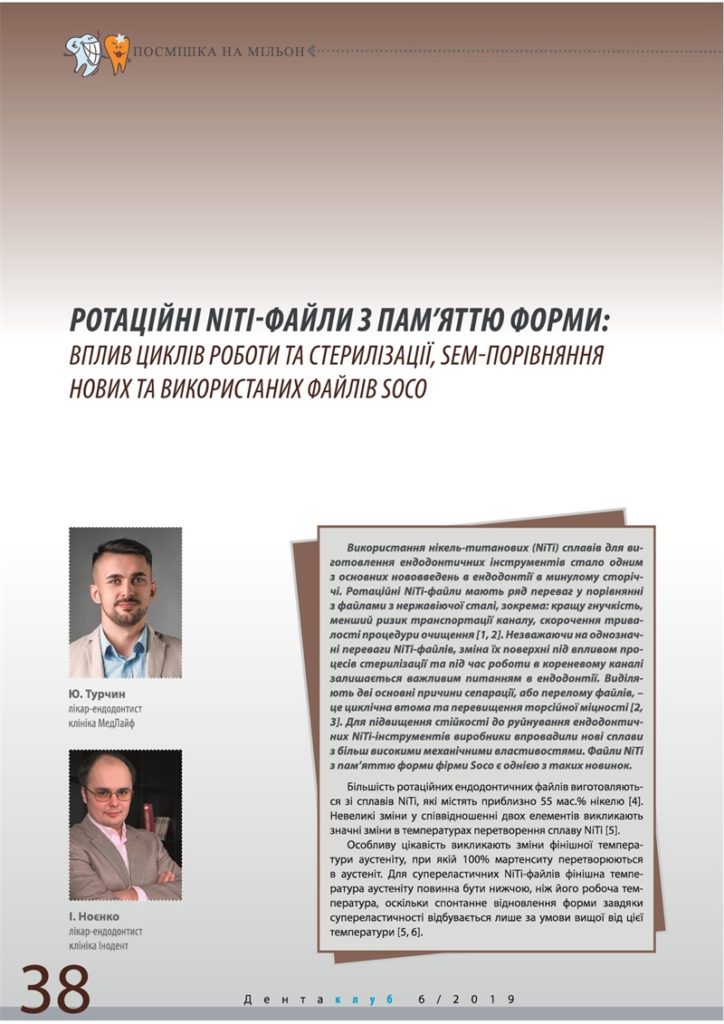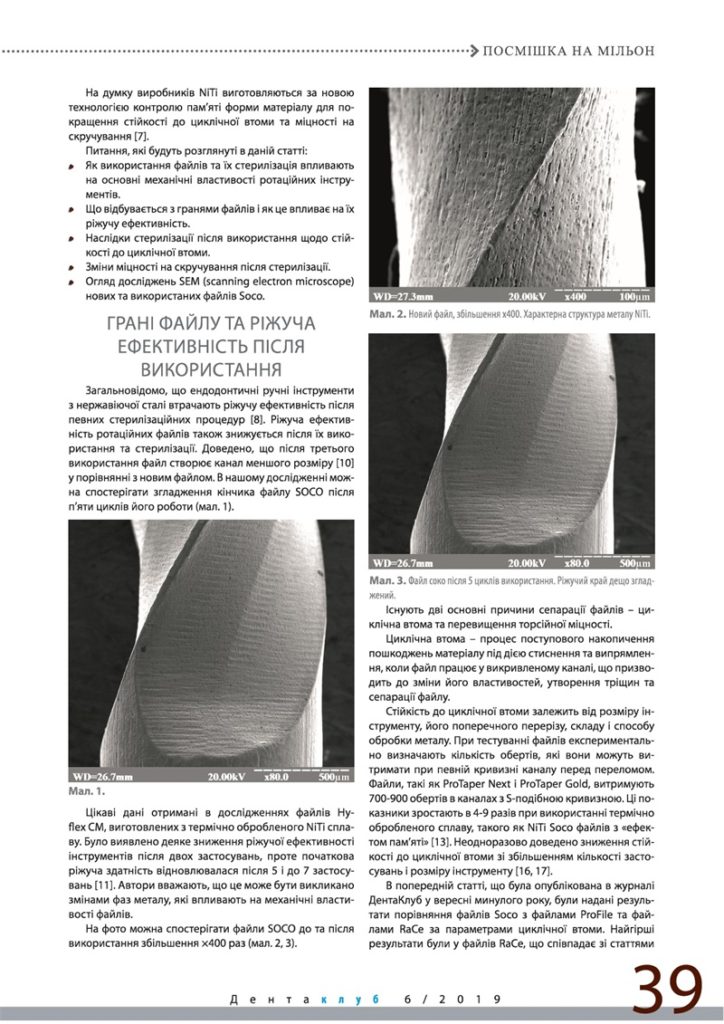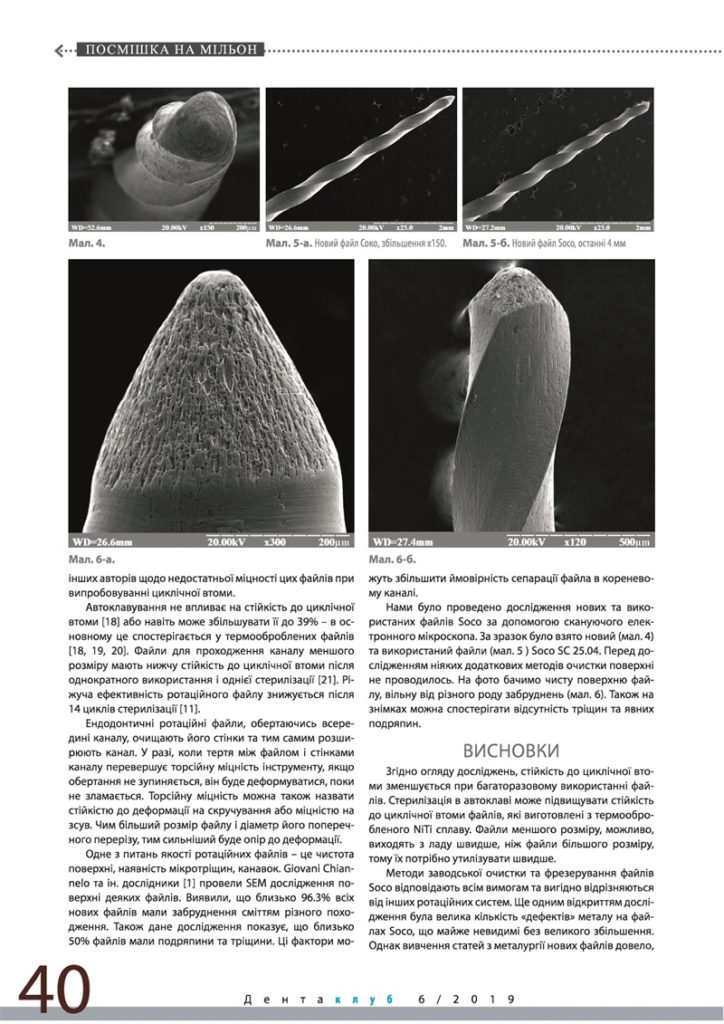The use of nickel-titanium (NiTi) alloys for manufacturing of endodontic instruments become one of the major innovations in endodontics in last century. Rotating NiTi files have a number of advantages over stainless steel files, including: better flexibility, less risk of channel transportation, shortening the duration of the cleaning/shaping procedure (1, 2). Despite the unique advantages of NiTi files, changes of their surface under the sterilization processes and during working in the root canal remains an important issue in endodontics. There are two main reasons for separation or fracture of endodontic files – cyclic fatigue and excess torsional forces (2-3). Manufacturers introduced new alloys with higher mechanical properties to increase resistance to fracture of endodontic NiTi-files. SOCO NiTi Controlled Memory files are one of such novelties. Most rotary endodontic files are made of NiTi alloys containing approximately 55% by weight nickel (4). The small changes in ratio of two elements cause significant changes in the conversion temperatures of NiTi alloy (5).
Of particular interest are changes in the austenite finishing temperature, at which 100% of martensite is converted into austenite. For superelastic NiTi-files austenite finish temperature should be lower than its working temperature, since spontaneous form recovery due to superelasticity occurs only at the higher temperature (5, 6). According to the manufacturers, Ni-Ti is manufactured using a new material memory control technology to improve cyclic fatigue strength and twisting strength (7).
Questions that will be considered in this article:
- How the use of files and their sterilization affect the basic mechanical properties of rotary files.
- What happens with files edges and how it affects their cutting efficiency.
- Consequences of sterilization after use on resistance to cyclic fatigue.
- Changes in twisting strength after sterilization.
- A review of SEM (scanning electron microscope) research on new and used SOCO files.
File edges and cutting efficiency after usage
Interesting data were obtained from studies of Hyflex CM files made from heat-treated Ni-Ti alloy. There was a slight decrease in the cutting efficiency of files after two uses, but the initial cutting efficiency was restored after 5 to 7 uses (11). The authors believe that this may be due to changes in the metal phases that affect the mechanical properties of the files.
It is well-known, that manual stainless steel endodontic files loose their cutting efficiency after sterilization procedures (8). The cutting efficiency of rotary files is also reduced after their use and sterilization. It is proved, that after the third use file creates smaller canal (10), comparing to new file. In our study, you can observe the smoothing of the tip of the file SOCO after five cycles of work (pic 1).
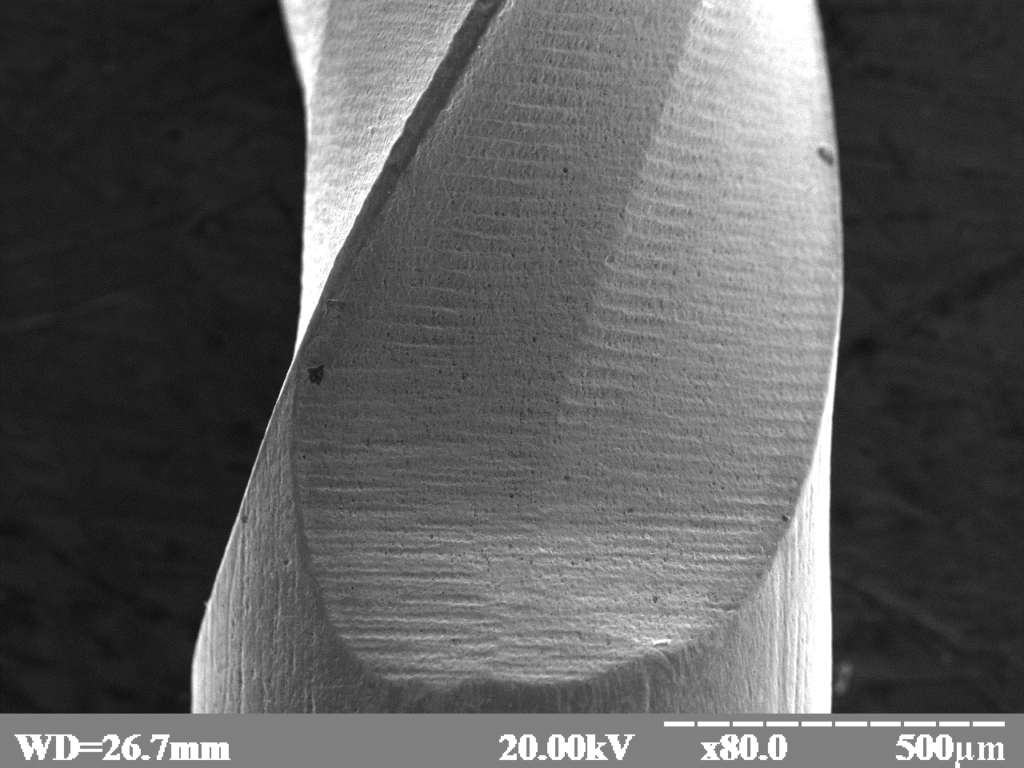
On the photo you can see SOCO files before and after usage, magnification x400.
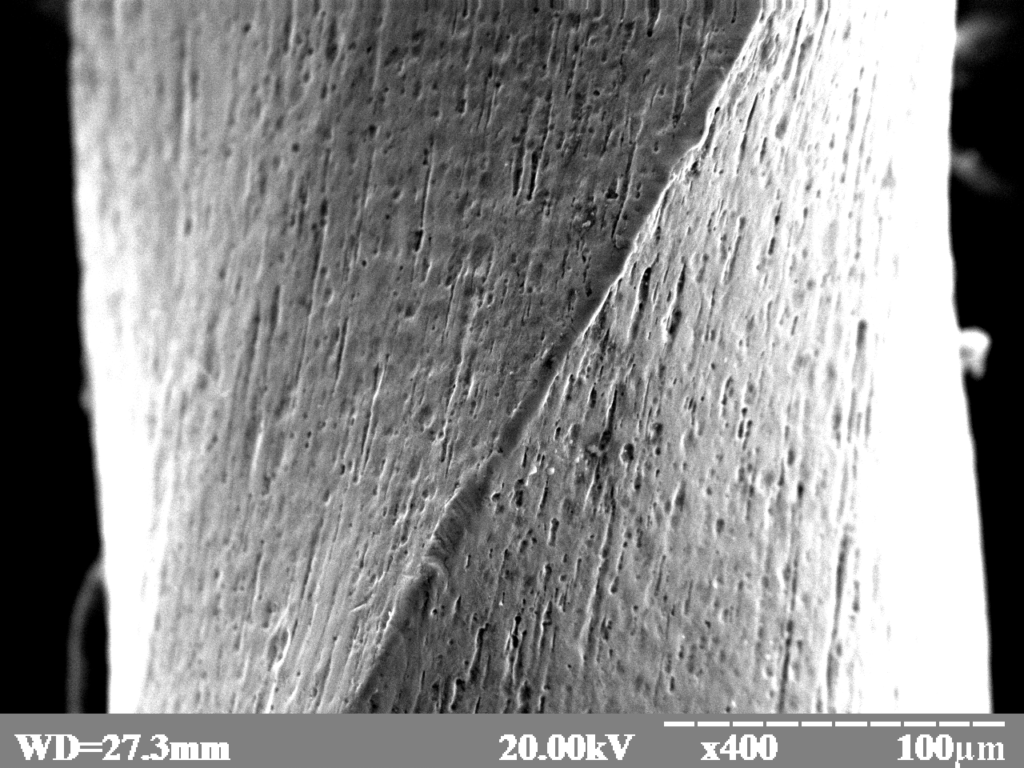
There are two main reasons for file breakage: cyclic fatigue and excess torsional strength.
Cyclical fatigue is the process of gradual accumulation of material damage by compression and straightening when the file works in a distorted canal, which changes its properties, creates cracks and separates the file.
Resistance to cyclic fatigue depends on the size of the file, its cross-section, composition and method of metal processing. When testing files, experimentally determine the number of rotations that they can withstand at a certain curvature of the root canal before the fracture. Files, such as ProTaper Next and ProTaper Gold, can withstand 700-900 rotations in canals with S-shaped curvature. These numbers increase up to 4-9 times, when using a thermally processed alloy such as Ni-Ti SOCO files with a “memory effect” (13). It has been repeatedly provne, that there is reducement in stability to cyclic fatigue with an increase in the number of uses and size of instruments (16, 17). In a previous article published in the magazine “Dentalclub” in September last year, the results of the comparison of SOCO files with Profile files and Race files on the parameters of cyclic fatigue, the worst results were in the Race files, which coincides with the articles of other authors regarding the insufficient Race file strength when experiencing cyclic fatigue.
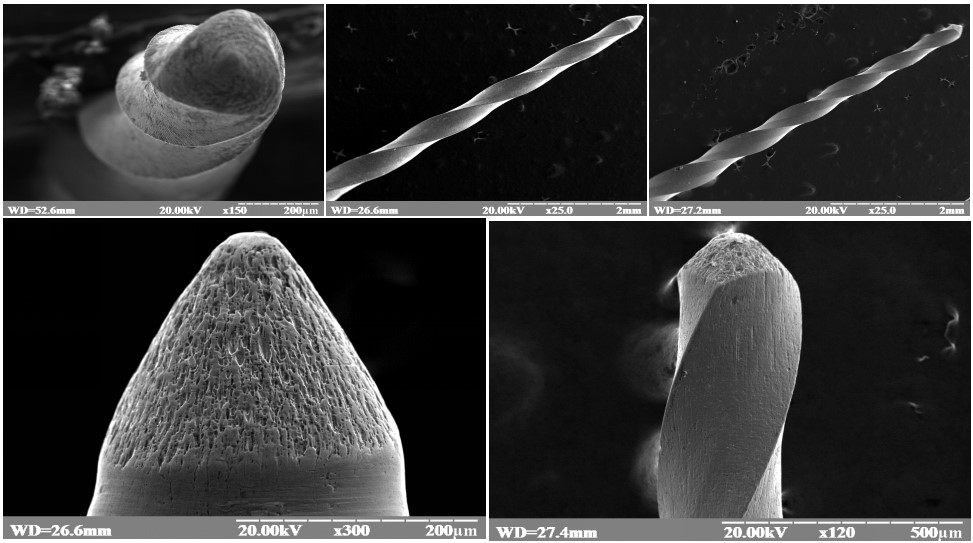
Autoclaving does not affect the resistance to cyclic fatigue (18), or even can increase it to 39% – this is mainly observed in heat-treated files (18,19,20). Files for passing a smaller canal have a lower resistance to cyclic fatigue after single use and one sterilization (21). The cutting efficiency of the rotary files decreases after 14 cycles of sterilization (11).
Endodontic rotary files, rotating inside the canal, clear canal walls and thus expand the canal. In the case where the friction between the file and the walls of the canal exceeds the torsional strength of the file, if the rotation does not stop, it will deform until it breaks. Torsional strength can also be called resistance to twisting or shear strength. The larger the file size and the diameter of its cross-section, the stronger will be the resistance to deformation.
One of the issues of the rotary files quality is the cleanliness of the surface, the presence of micro cracks, grooves. Giovani Chiannelo et al. (1) conducted a SEM study on the surface of some files. They found that about 96.3% of all new files had been contamination with debris of different origin. Also, this study shows that about 50% of the files had scratches and cracks. These factors may increase the likelihood of separating the file from the root canal.
We studied the new and used SOCO files using a scanning electron microscope. As a sample, a new one (photo 1) and a used file were taken (photo 2) SOCO SC 25.05. Before the study, no additional surface treatment methods were performed. In the photo we see a clean surface of the file, free of all kinds of contamination (photo 5). Also, in the pictures you can observe the absence of cracks and obvious scratches.
Conclusions:
According to the survey, the resistance to cyclic fatigue decreases with multiple use of files. Sterilization in an autoclave can increase the resistance to cyclic fatigue of files made of heat-treated Ni-Ti alloy. Smaller files may fail faster than larger files, so they need to be disposed of faster.
The methods of factory cleaning and milling of SOCO files meet all requirements and benefit from other rotary systems. Another discovery of the study was the large number of “defects” of metal on SOCO files, which are almost invisible without a large increase. However, the articles review in metallurgy of new files has proven that this is not a problem in files, but is a consequence of heat treatment and does not affect the quality and characteristics of files. The same defects are found on other files of more well-known manufacturers, such as Hyflex (Coltene), which was one of the first to offer CM files. Recent studies have shown that the ultra smooth surface achieved by electro-polishing is inherent in some files, has no effect on their properties and is more of a marketing moment, as evidenced by the fact that almost all firms have abandoned this stage of processing endodontic files and focused on modernization of alloys in order to achieve the best results.
Literature:
- Civjan S, Huget EF, DeSimon LB. Potential applications of certain nickel-titanium (nitinol) alloys. J Dent Res 1975;54:89 –96.
- ShortJA,MorganLA,BaumgartnerJC.Acomparisonofcanalcenteringabilityoffour instrumentation techniques. J Endod 1997;23:503–7.
- GuelzowA,StammO,MartusP,KielbassaAM.Comparativestudyofsixrotarynickel- titanium systems and hand instrumentation for root canal preparation. Int Endod J 2005;38:743–52.
- Lloyd A. Root canal instrumentation with ProFile instruments. Endod Topics 2005;10:151– 4.
- HimelVT,AhmedKM,WoodDM,AlhadainyHA.Anevaluationofnitinolandstainless steel files used by dental students during a laboratory proficiency exam. Oral Surg Oral Med Oral Pathol Oral Radiol Endod 1995;79:232–7.
- PettietteMT,MetzgerZ,PhillipsC,TropeM.Endodonticcomplicationsofrootcanal therapy performed by dental students with stainless-steel K-files and nickel-titanium hand files. J Endod 1999;25:230 – 4.
- Javaheri HH, Javaheri GH. A comparison of three Ni-Ti rotary instruments in apical
transportation. J Endod 2007;33:284 – 6. - Surface Finishing of Unused Rotary Endodontic Instruments: A SEM Study ISSN 1806-4760Braz. Dent. J. vol.19 no.2 Ribeirão Preto
- Haïkel et al. Effects of cleaning, disinfection, and sterilization procedures on the cutting efficiency of endodontic files. J Endod 1996;22(12):657–661
- Ounsi et al. Comparison of Two Techniques for Assessing the Shaping Efficacy of Repeatedly Used Nickel-Titanium Rotary Instruments. J Endod 2011;37:847–850
- Rapisarda E et al. Effect of sterilization on the cutting efficiency of rotary nickel-titanium endodontic files. OOOOE. 1999 Sep;88(3):343-7
- Seago et al. Effect of Repeated Simulated Clinical Use and Sterilization on the Cutting Ef?ciency and Flexibility of Hy?ex CM Nickel-Titanium Rotary Files. J Endod. 2015 May;41(5):725-8
- Shen et al. Effect of environment on fatigue failure of controlled memory wire nickel-titanium rotary instruments. J Endod. 2012 Mar;38(3):376-80
- Vieira et al. Influence of multiple clinical use on fatigue resistance of ProTaper rotary nickel-titanium instruments. Int Endod J. 2008 Feb;41(2):163-72
- Gambarini. Cyclic fatigue of ProFile rotary instruments after prolonged clinical use. Int Endod J. 2001 Jul;34(5):386-9
- Pedullà et al. Cyclic fatigue resistance of nickel-titanium instruments after immersion in irrigant solutions with or without surfactants. J Endod 2014;40:1245–1249
- Berutti et al. Influence of sodium hypochlorite on fracture properties and corrosion of ProTaper Rotary instruments. Int Endod J. 2006 Sep;39(9):693-9
- Plotino et al. Experimental Evaluation on the Influence of Autoclave Sterilization on the Cyclic Fatigue of New Nickel-Titanium Rotary Instruments. J Endod 2012;38:222–225
- Viana et al. Influence of sterilization on mechanical properties and fatigue resistance of nickel-titanium rotary endodontic instruments. Int Endod J. 2006 Sep;39(9):709-15
- Zhao et al. Effect of autoclave sterilization on the cyclic fatigue resistance of thermally treated Nickel-Titanium instruments. Int Endod J. 2016 Oct;49(10):990-5
- Özyürek et al. A Comparison of the Cyclic Fatigue Resistance of Used and New Glide Path Files. J Endod. 2017 Mar;43(3):477-480
- Yared. In Vitro Study of the Torsional Properties of New and Used ProFile Nickel Titanium Rotary Files. J Endod 2004 Apr;30(6):410
- Svec et al. The deterioration of rotary nickel-titanium files under controlled conditions. J Endod. 2002 Feb;28(2):105-7
The original article:



